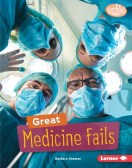
Do all discoveries, inventions, and innovations require plans and procedures? Nope. Serendipity, a blend of chance and wisdom, play a huge part in many instances. Tales of accidental brilliance are fun to read and show us the part in plays in all of our lives. Here’s a list of books that tell tales of serendipity.
Accidental Archeologists: True Stories of Unexpected Discoveries by Sarah Albee
Sarah Albee tells tales of the secret treasures that are found all around us in Accidental Archeologists. Readers will discover many incredible tales in this book of accessible archeology.
Building Blunders: Learning from Bad Ideas by Amie Jane Leavitt
As a part of the series Fantastic Fails, this book shares building failures that led to learning.
Gadget Disasters: Learning from Bad Ideas by Elizabeth Pagel-Hogan
Another in the Fantastic Fails series, Gadget Disasters introduces readers to gadgets gone wrong and what designers learn from those missteps.
How to Become an Accidental Genius by Freida Wishinsky and Elizabeth MacLeod, Illustrated by Jenn Playford
Yes, you can become an accidental genius too, according to these two authors, who share a series of inspiring tales of global inventors.
Mistakes That Worked: 40 Familiar Inventions and How They Came to Be by Charlotte Foltz Jones, Illustrated by John O’Brien
Readers will find the stories of common things, like potato chips, and their chance invention. Mistakes can lead to success.
Rhinos in Nebraska: The Amazing Discovery of the Ashfall Fossil Beds by Allison Pearce Stevens, illustrated by Matt Huynh
It’s difficult to believe that rhinos, elephants, and camels once roamed North America. Readers will learn about a startling archeological discovery right in the heart of Nebraska in this book that proved their existence.
All In a Drop: How Antony van Leeuwenhoek Discovered an Invisible World by Lori Alexander, illustrated by Vivien Mildenberger
Lori Alexander tells the fascinating story of self-taught scientist, Antony van Leeuwenhoek’s great discovery.
Accidental Inventions: The Chance Discoveries That Changed Our Lives by Birgit Krols
Here is another book that features the backstories of some of our most important, fun, and useful inventions.
Great Medicine Fails by Barbara Krasner
Can bloodletting with leeches actually lead to a medical success? Read about some of the biggest failures in medicine that led to important success.
Alexander Fleming: Scientists and their Discoveries by Bradley Sneddon
Penicillin is one of the world’s greatest discoveries and has one of the most fascinating stories. Discover how a chance mold contamination led to saving countless lives across the planet.

Nancy Castaldo has written books about our planet for over 20 years including, THE STORY OF SEEDS, which earned the Green Earth Book Award, Junior Library Guild Selection, and other honors. Nancy’s research has taken her all over the world from the Galapagos to Russia. She strives to inform, inspire, and empower her readers. Nancy also served as Regional Advisor Emeritus of the Eastern NY SCBWI region. Her 2020 international title about farm and food is THE FARM THAT FEEDS US: A Year In The Life Of An Organic Farm. Visit her at www.nancycastaldo.com.

Patricia Newman writes middle-grade nonfiction that empowers young readers to act on behalf of the environment and their communities. Academy Award winner and environmentalist Jeff Bridges calls Planet Ocean a “must read.” Newman, a Sibert Honor author of Sea Otter Heroes, has also received an NSTA Outstanding Science Trade Book Award for Eavesdropping on Elephants, a Green Earth Book Award for Plastic, Ahoy!, and a Eureka! Gold Medal from the California Reading Association for Zoo Scientists to the Rescue. Her books have received starred reviews, been honored as Junior Library Guild Selections, and included on Bank Street College’s Best Books lists. During author visits, she demonstrates how young readers can use writing to be the voice of change. Visit her at www.patriciamnewman.com.
















 Your host is
Your host is 











 Maria is a children’s author, blogger, and poet passionate about making nature and reading fun for children. She’s been a judge for the Cybils Awards from 2017 to present. And a judge for the #50PreciousWords competition since its inception. Her poems are published in The Best Of Today’s Little Ditty 2017-2018, 2016, and 2014-2015 anthologies. When not writing, critiquing, or reading, she bird watches, travels the world, bakes, and hikes. Visit her at
Maria is a children’s author, blogger, and poet passionate about making nature and reading fun for children. She’s been a judge for the Cybils Awards from 2017 to present. And a judge for the #50PreciousWords competition since its inception. Her poems are published in The Best Of Today’s Little Ditty 2017-2018, 2016, and 2014-2015 anthologies. When not writing, critiquing, or reading, she bird watches, travels the world, bakes, and hikes. Visit her at